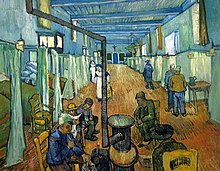Death of Vincent van Gogh
Vincent van Gogh died in the early morning of 29 July 1890 in his room at the Auberge Ravoux, in the French village of Auvers-sur-Oise, after presumably shooting himself two days earlier.
As early as 1883, Vincent van Gogh wrote to his brother Theo: "... as to the time I still have ahead of me for work, I think I may safely presume that my body will hold up for a certain number of years... between 7-10, say", "...
[4][5] Theo originally resisted this choice, even suggesting that Vincent rejoin Paul Gauguin in Pont Aven, but was eventually won over, agreeing to pay the asylum fees (requesting the cheapest third-class accommodation).
[6][7] His mental condition remained stable for a while, and he was able to work en plein air, producing many of his most iconic paintings, such as The Starry Night, at this time.
[15][16] On about 12 June, he wrote to his friends Mr and Mrs Ginoux in Arles, telling them how his health had suffered at Saint-Rémy but had since improved: "But latterly I had contracted the other patients' disease to such an extent that I could not be cured of my own.
Then I felt I had better try a change, and for that matter, the pleasure of seeing my brother, his family and my painter friends again has done me a lot of good, and I am feeling completely calm and normal.
"[20] In another letter to Theo on about 10 July, van Gogh explains: "I try to be fairly good-humoured in general, but my life too is threatened at its very root, and my step is unsteady too."
In a letter dated 22 July 1890, he wrote, "I hope, my dear Vincent, that your health is good, and since you say that you write with difficulty, and don't talk about your work I am a little afraid that there is something troubling you or not going right."
When he asked whether he was ill, Van Gogh showed him a wound near his heart, admitting that during the night, he had set out for the wheat field where he had recently been painting and attempted suicide by shooting himself.
Adeline goes on to explain how her father sent Anton Hirschig, also a Dutch artist staying in the inn, to alert the local physician, who proved to be absent.
"[27] As soon as the post office opened on Monday morning, Adeline's father sent a telegram to van Gogh's brother, Theo, who arrived by train during the afternoon.
"[29] In her memoir of December 1913, Theo's wife Johanna refers first to a letter from her husband after he arrives at Vincent's bedside: "He was glad that I came and we are together all the time... Poor fellow, very little happiness fell to his share, and no illusions are left him.
"[30] In addition to the account given by Adeline Ravoux, Émile Bernard's letter to Albert Aurier provides details of the funeral which was held in the afternoon of 30 July 1890.
Van Gogh's body was set out in "the painter's room" where it was surrounded by the "halo" of his last canvases and masses of yellow flowers including dahlias, and sunflowers.
Gachet, trying to suppress his tears, could only say a few words of praise, expressing his admiration for an "honest man and a great artist... who had only two aims, art and humanity.
"[27][30] In 2011, authors Steven Naifeh and Gregory White Smith published a biography, Van Gogh: The Life, in which they challenged the conventional account of the artist's death.
[31] Naifeh and Smith developed an alternative hypothesis in which van Gogh did not commit suicide but rather was a possible victim of accidental manslaughter or foul play.
[32] Naifeh and Smith point out that the bullet entered van Gogh's abdomen at an oblique angle, not straight as might be expected from a suicide.
[33] The authors contend that art historian John Rewald visited Auvers in the 1930s, and recorded the version of events that is widely believed.
The authors postulate that after he was fatally wounded, van Gogh welcomed death and believed the boys had done him a favour, hence his widely quoted deathbed remark: "Do not accuse anyone... it is I who wanted to kill myself.
[31] Some credence has been given to the theory by van Gogh experts, who cite an interview with French businessman René Secrétan recorded in 1956, in which he admitted to tormenting—but not shooting—the artist.
In 2014, at Smith and Naifeh's request, a chief medical examiner Vincent Di Maio reviewed the forensic evidence surrounding van Gogh's shooting.
The letters he wrote during his last two months offer a considerable amount of background on van Gogh's relentless will to paint coupled with frequent periods of despondency.



Oil on canvas, 65 cm × 54 cm
Musée d'Orsay , Paris. This may have been van Gogh's last self-portrait. [ 22 ]



